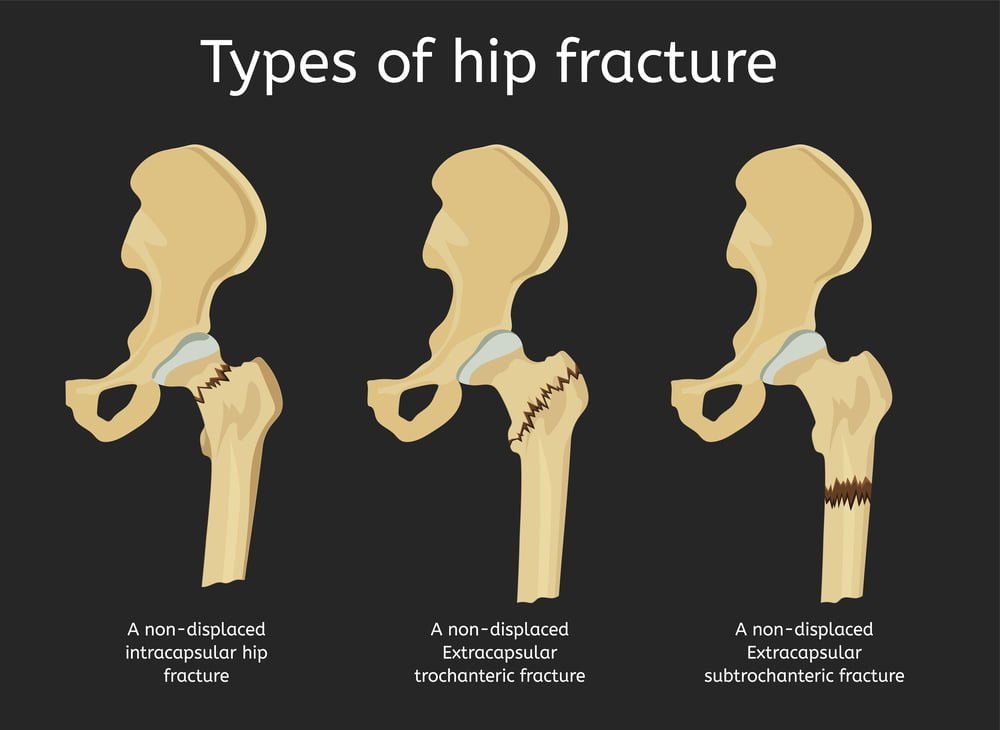
A hip fracture occurs when the femur’s upper portion fractures. Usually, a fall or car accident causes injuries. Older adults are more likely to suffer from hip fractures because as we age, our bones become more fragile. Most hip fractures occur in patients over the age of 60. Hip fractures are more common as people age, tripling every ten years after age 50. Asians and Caucasians are more susceptible than others to the condition. The prevalence of osteoporosis is the main cause of this. Osteoporosis is a condition that weakens bones by causing bone tissue to disappear.
Most hip fractures result in excruciating pain and necessitate prompt treatment. After a hip fracture, some people require a total hip replacement. The outlook for persons with hip fractures can be improved with physical therapy (PT).
Who are most in danger?
Women experience it more frequently than men do. Women are more prone to fall than males do, and they are also more likely to develop osteoporosis, a condition that weakens bones.
Other factors that raise your risk of developing a hip fracture include:
- Having a low weight
- Not obtaining enough vitamin D or calcium
- Osteoporosis runs in the family
- Inadequate exercise
- Overindulging in booze
- Smoking
Additionally, stress fractures, or tiny fissures in the bone, can occur in the hips of ballet dancers and distance runners. If they are not treated, they may eventually become larger.
The most common types of hip fractures are
Femoral neck fracture
One to two inches from your hip joint, you can sustain a femoral neck fracture. This kind of fracture can be linked to osteoporosis and is typical in older persons. Because the break typically cuts off the blood supply to the head of the thigh bone, which makes up the hip joint, this sort of fracture may result in complications.
Intertrochanteric hip fracture
Three to four inches from your hip joint is where an intertrochanteric hip fracture occurs. This kind of fracture may be simpler to fix because it typically does not cut off your bone’s blood supply.
These two categories account for the majority of hip fractures, roughly equal in number. A stress fracture of the hip is a different form of fracture that may be more difficult to identify. There may not be a full fracture of your thigh bone due to this hairline crack. A stress fracture can be brought on by overuse and repetitive motion. The signs of this injury could resemble tendinitis or a strained muscle.
What causes a hip fracture?
The most frequent cause of a hip fracture in elderly people is a fall. A hip fracture may occur suddenly in a small number of persons. When you’re younger, a hip fracture usually happens as a result of a car accident, a serious fall, or other traumatic events.
Older persons are more likely to suffer a hip fracture. This is because as a person ages, calcium loss causes bones to become thinner and weaker. Osteoporosis is typically to blame for this.
If you fall, your osteoporotic bones are more prone to break. The majority of hip fractures in elderly individuals arise from falling while walking on a flat surface, frequently at home.
As women age, their bone density decreases by 30% to 50%. Because you produce less oestrogen after menopause, the loss of bone accelerates quickly. Estrogen helps to preserve bone strength and density.
Symptoms of a hip fracture
Hip fracture symptoms frequently appear out of the blue. However, they could start out mildly and get worse over time.
Pain
Hip pain is typically intense and sharp. But it might also be slight or uncomfortable. Most people have pain in their groin, outer hip, thigh, and pelvis. Your leg may feel the pain that comes from your buttock (sciatica). Your knee may also be hurting.
Limited mobility
Most hip fracture sufferers are unable to stand or walk. It is occasionally feasible to walk, but putting weight on the leg is excruciatingly painful.
Physical changes
On your hip, there could be a bruise. Your legs might seem shorter on one side than the other. The hip may appear to be rotated, twisted, or out of place.
How is a hip fracture diagnosed?
A medical professional will inspect the area and inquire about any recent falls or injuries. Your healthcare professional might touch your foot or leg and ask you whether you feel anything in order to test for nerve injury (neuropathy).
Your doctor conducts imaging studies to identify a fracture and examine any soft tissue damage. These may consist of:
- X-ray, which creates images of your bones using radiation.M
- MRI, a powerful magnet, is used in MRI imaging to produce images of bones and soft tissues.
- A CT scan gives your doctor a thorough view of the damaged area by using a computer and numerous X-rays.
Treatment of hip fractures
Treatment for hip fractures is based on your age, general health, and type of damage. Within a day or two of the incident, surgery is usually necessary for hip fractures.
Surgery
The majority of hip fractures require surgery. There are various hip surgery procedures. In order to fix the bones and keep them in place, your provider could use metal screws, nails, or plates.
Hip replacement
You may require a partial or complete hip replacement depending on the nature of your damage. Your doctor could advise that you rehabilitate in a rehab center after hip replacement surgery.
Physical therapy (PT)
To help you restore mobility, flexibility, and strength, your physical therapist will design a PT program. Following hip replacement surgery, specific workouts can greatly increase your range of motion.
Medication
Prescription and over-the-counter painkillers can help you manage pain and lower inflammation. Antibiotics may be given to you after hip surgery to lower the chance of infection.
Surgery to treat hip fractures
The location and severity of the fracture, whether the shattered bones are misaligned (displaced), your age and underlying medical issues all play a role in determining the type of surgery.
Internal repair using screws
In order to keep the bone together while the fracture heals, metal screws are placed inside of it. On occasion, a metal plate that goes down the thigh bone is fastened with screws (femur).
Total hip replacement
Artificial components are used to replace the pelvic bone socket and upper femur (prostheses). Total hip replacement is increasingly more cost-effective and linked to better long-term results in otherwise healthy adults who live independently, according to research.
Partial hip replacement
In some cases, it is not necessary to replace the hip socket. Adults with various medical issues or those who can no longer live independently may be advised to get a partial hip replacement.
If the blood supply to the ball portion of the hip joint was compromised during the fracture, a full or partial hip replacement may be advised by the surgeon. The likelihood of the bone healing properly is decreased with that kind of damage, which most frequently affects older adults with femoral neck fractures.
Major orthopedic Implants for hip fracture
In a nutshell…
Hip Prosthesis implants by Zealmax Ortho are designed to stabilize the femur and restore hip function speedily in the treatment of fractures of the femoral neck. All the implants are made up of high-quality medical grade stainless steel which is available in different head sizes to fit accurately. We ensure each product of ours passes the quality test and meets the standards so that our clients get value for their money.


